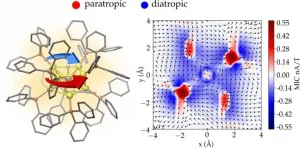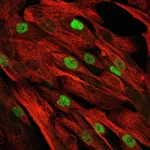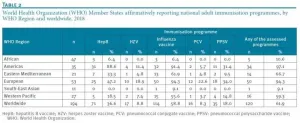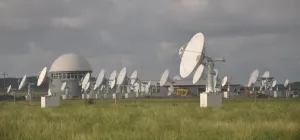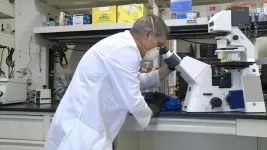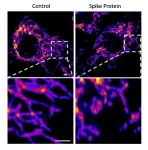Highly efficient photodynamic-immunotherapy by combining AIEgen with Poly(I:C)
2021-04-30
(Press-News.org) Immunotherapy is a type of anti-tumor treatment and has shown great clinical success against a wide variety of malignancies in recent years. Poly(I : C), a TLR3 agonist, is the most potent type I interferon (IFN) inducer. Poly(I : C) not only directly induces tumorous apoptosis, but also stimulates tumor cells to secrete immune factors. However, the immune response rate induced by Poly(I : C) remains low in several types of malignancies and higher doses are often required to achieve the desired effect. However, poly(I : C) is highly toxic and thus only a very narrow therapeutic window is available, which greatly limits clinical application of Poly(I : C)-based treatments.
Photodynamics therapy (PDT) is a promising anti-tumor treatment method, which not only directly induces the production of excessive reactive oxygen species (ROS) in tumor cells, but also promotes the release of tumor-related antigens, thereby initiating the anti-tumor immunity. The photosensitive activity of traditional photosensitizers is weakened or even completely disappeared in the state of aggregation, which is a major problem in PDT. Fortunately, the emergence of AIEgens presents a new strategy for the construction of effective photosensitizers. The AIEgens has a stronger ability to generate ROS and produces a stronger immune effect in the aggregated state. Even so, the immunity induced by photodynamic therapy is still difficult to achieve complete tumor elimination. Therefore, combining the immune adjuvant Poly(I:C) with AIE photosensitizer-mediated photodynamic therapy to enhance the anti-tumor immune response is of great clinical significance.
Recently, Shixuan Wang from Huazhong University of Science and Technology of China, Fan Xia from the China University of Geosciences and Yuning Hong the La Trobe University of Australia reported the preparation of NPs that comprise an AIE-conjugated polymer as a photosensitizer and Poly(I : C) as an immunologic adjuvant, a PLGA matrix and an red blood cell (RBC) membrane shell, which provide a novel strategy for tumor treatment.
In order to enhance the good biocompatibility and specific organ targeting of the NPs, the authors used the red blood cell membrane as the shell, simultaneously loaded the AIEgens and the immune adjuvant Poly(I:C) to construct the M@AP NPs. In vivo, M@AP NPs are mainly enriched in tumor tissues because of the ERP effect, but they also accumulate in the spleen through the homing effect of the RBC membrane. The latter activates immune cells in the spleen to strengthen anti-tumor immunity. Under white light irradiation on the tumor region, the AIE photosensitizer induces tumor cell death by generating intracellular ROS, which further promotes the release of TA and activates the immune response with a synergistic effect of Poly(I : C). Quantitative analysis revealed that M@AP NPs simultaneously kill local cancer cells directly and stimulate the immune cells to release cytokines that present cytotoxicity against tumor cells. The authors further applied the system in a lung metastasis mouse model and demonstrated the excellent anti-metastasis capability of our approach, which provides a potential treatment strategy for preventing tumor recurrence and metastasis.
INFORMATION:
See the article:
https://doi.org/10.1093/nsr/nwab039
[Attachments] See images for this press release:
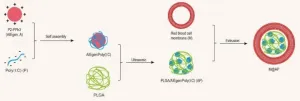
ELSE PRESS RELEASES FROM THIS DATE:
2021-04-30
Many industrial processes emit carbon dioxide into the atmosphere. Unfortunately, however, current electrochemical separation methods are expensive and consume large amounts of power. They also require expensive and rare metals as catalysts. A study in the journal Angewandte Chemie describes a new aerogel electrocatalyst formed from an inexpensive metal alloy, which enables highly efficient electrochemical conversion of carbon dioxide. The main product is formic acid, which is a nontoxic basic chemical.
Capturing and chemically fixing carbon dioxide from industrial processes would be a huge step towards carbon neutrality. To prevent the ...
2021-04-30
Researchers in the Nanoscience Center of University of Jyvaskyla, in Finland and in the Guadalajara University in Mexico developed a method that allows for simulation and visualization of magnetic-field-induced electron currents inside gold nanoparticles. The method facilitates accurate analysis of magnetic field effects inside complex nanostructures in nuclear magnetic resonance measurements and establishes quantitative criteria for aromaticity of nanoparticles. The work was published 30.4.2021 as an Open Access article in Nature Communications.
According to the classical electromagnetism, a charged particle moving in an external magnetic field experiences a force that makes the particle's path circular. This basic law of physics is used, e.g., in designing cyclotrons ...
2021-04-30
Muscle stem cells enable our muscle to build up and regenerate over a lifetime through exercise. But if certain muscle genes are mutated, the opposite occurs. In patients suffering from muscular dystrophy, the skeletal muscle already starts to weaken in childhood. Suddenly, these children are no longer able to run, play the piano or climb the stairs, and often they are dependent on a wheelchair by the age of 15. Currently, no therapy for this condition exists.
"Now, we are able to access these patients' gene mutations using CRISPR-Cas9 technology," explains Professor Simone Spuler, head of the Myology Lab at the Experimental and Clinical Research Center (ECRC), a joint institution of the Max Delbrück Center for Molecular Medicine in the Helmholtz Association and Charité ...
2021-04-30
Effectively and safely protecting against disease--this is what makes vaccines a vital and successful public health tool that saves lives and safeguards health and well-being. Today, vaccines shield us from more than 20 life-threatening diseases.
Each year, between 2 to 3 million lives are saved by immunisation against diseases like diphtheria, tetanus, pertussis, influenza or measles [1]. However, several vaccines such as the one against measles can only reach their full potential--protecting not just those who are immunised, but also those who might not be eligible for vaccination--if ...
2021-04-30
Prof. YAN Yihua and his research team from the National Astronomical Observatories of the Chinese Academy of Sciences (NAOC) recently released detailed results of observations by the new generation solar radio telescope--Mingantu Spectral Radio Heliograph (MUSER)--from 2014 to 2019.
The study was published in Frontiers in Astronomy and Space Sciences on March 29. It may help us better understand the basic nature of solar eruptions.
Solar radio bursts are associated with different types of powerful eruptions like solar flares, coronal mass ejections, and various thermal and nonthermal processes. They are prompt indicators of disastrous space weather events.
Solar radio observations, especially at centimeter ...
2021-04-30
As the health of ecosystems in regions around the globe declines due to a variety of rising threats, scientists continue to seek clues to help prevent future collapses.
A new analysis by scientists from around the world, led by a researcher at the University of California San Diego, is furthering science's understanding of species interactions and how diversity contributes to the preservation of ecosystem health.
A coalition of 49 researchers examined a deep well of data describing tree species in forests located across a broad range of countries, ecosystems and latitudes. Information about the 16 forest diversity plots in Panama, China, Sri Lanka, Puerto Rico and other locations--many in remote, inaccessible ...
2021-04-30
Jeremy Edwards, director of the Computational Genomics and Technology (CGaT) Laboratory at The University of New Mexico, and his colleagues at Centrillion Technologies in Palo Alto, Calif. and West Virginia University, have developed a chip that provides a simpler and more rapid method of genome sequencing for viruses like COVID-19.
Their research, titled, "Highly Accurate Chip-Based Resequencing of SARS-CoV-2 Clinical Samples" was published recently in the American Chemical Society's Langmuir. As part of the research, scientists created a tiled genome array they developed for rapid and inexpensive full viral genome resequencing and applied their SARS-CoV-2-specific genome tiling array to rapidly and accurately resequenced ...
2021-04-30
Boston, MA (April 30, 2021) - A new study, presented today at the AATS 101st Annual Meeting, shows that non-invasive cell-free DNA tests can reduce the need for regular surveillance biopsies to detect early rejection in heart transplant patients. The study was the first of its kind to be performed on both adult and pediatric patients.
Pediatric and adult heart transplant recipients were recruited prospectively from eight participating sites and followed longitudinally for at least 12 months with serial plasma samples collected immediately prior to all endomyocardial biopsies. Structured biopsy results and clinical data were collected and monitored by an independent clinical research organization (CRO).
For ...
2021-04-30
Boston, MA (April 30, 2021) - A new study, presented today at the AATS 101st Annual Meeting, found that severely ill COVID-19 patients treated with ECMO did not suffer worse long-term outcomes than other mechanically-ventilated patients. The multidisciplinary team included cardio thoracic surgeons, critical care doctors, medical staff at long-term care facilities, physical therapists and other specialists, and followed patients at five academic centers: University of Colorado; University of Virginia; University of Kentucky; Johns Hopkins University; and Vanderbilt University. ...
2021-04-30
LA JOLLA--(April 30, 2021) Scientists have known for a while that SARS-CoV-2's distinctive "spike" proteins help the virus infect its host by latching on to healthy cells. Now, a major new study shows that they also play a key role in the disease itself.
The paper, published on April 30, 2021, in Circulation Research, also shows conclusively that COVID-19 is a vascular disease, demonstrating exactly how the SARS-CoV-2 virus damages and attacks the vascular system on a cellular level. The findings help explain COVID-19's wide variety of seemingly unconnected complications, and could ...
LAST 30 PRESS RELEASES:
[Press-News.org] Highly efficient photodynamic-immunotherapy by combining AIEgen with Poly(I:C)

